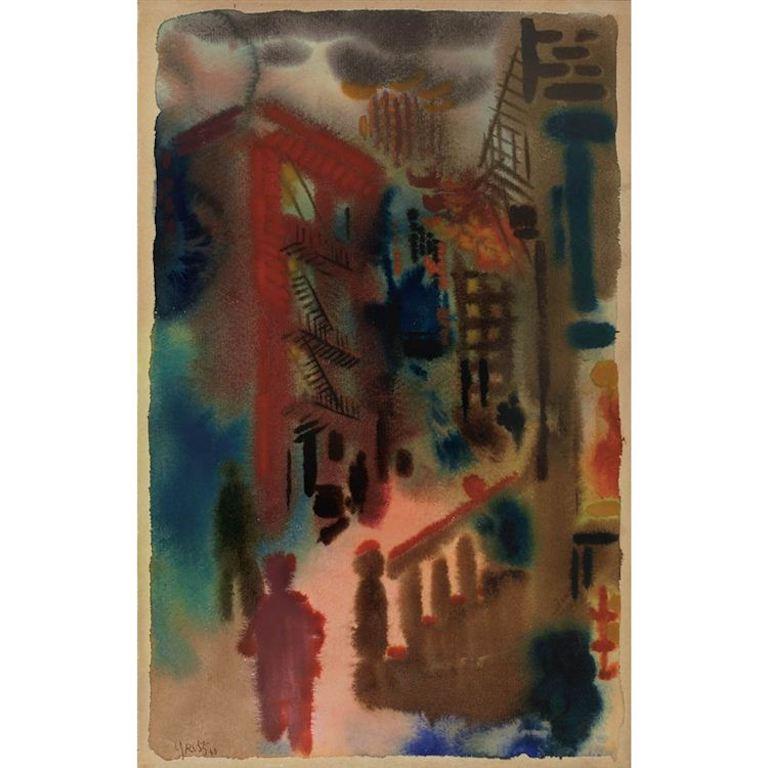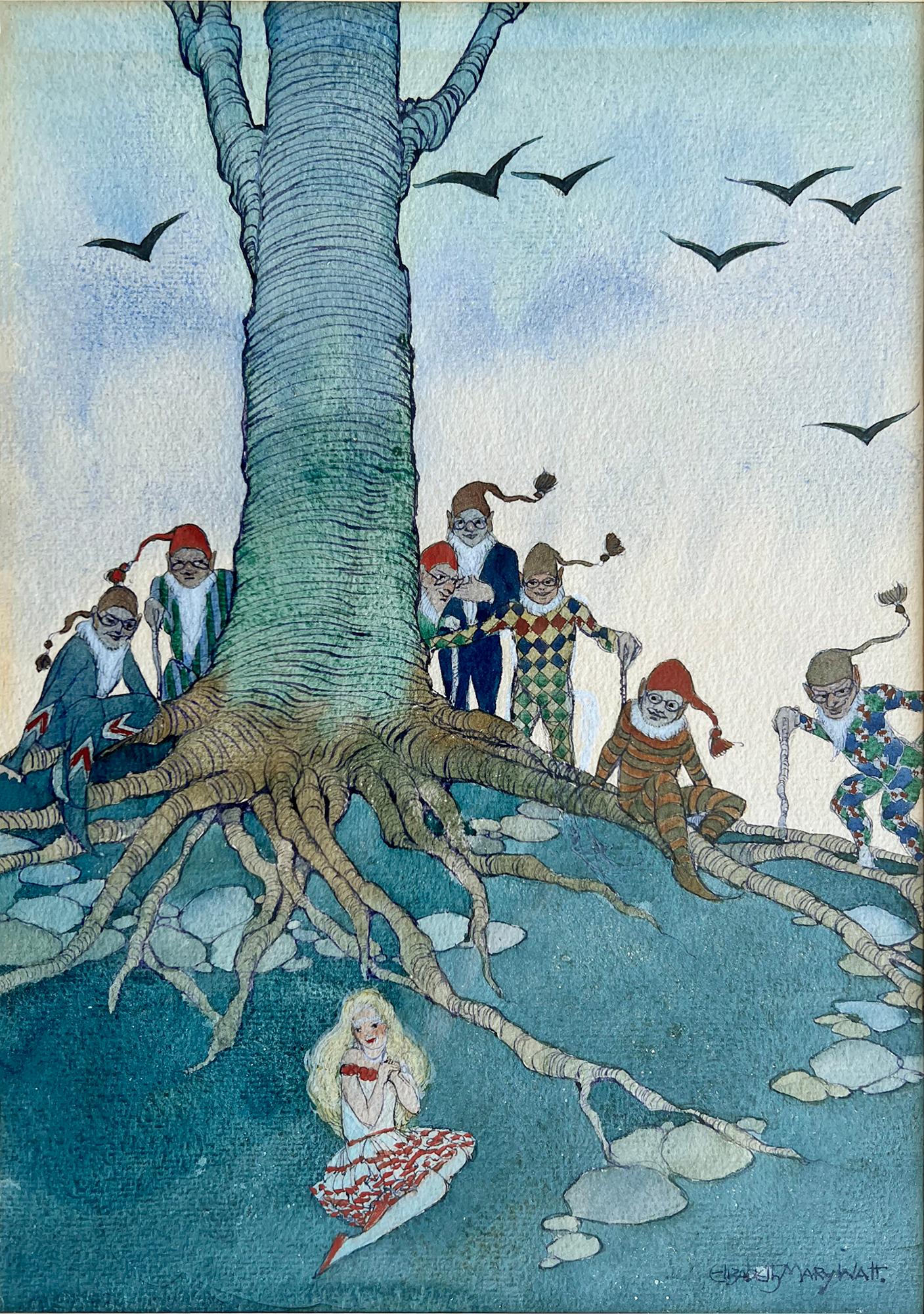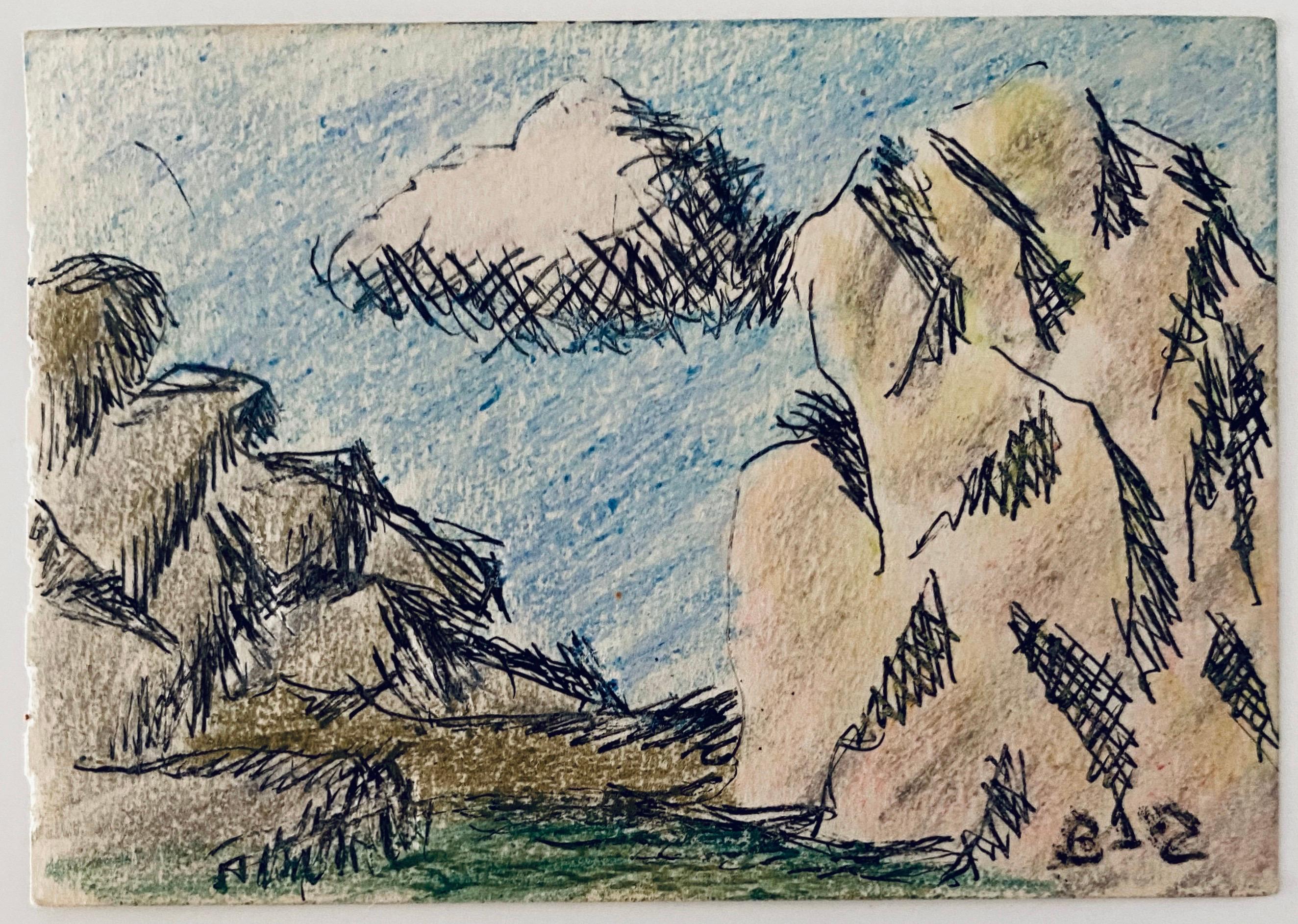Items Similar to Le Pont Neuf
Want more images or videos?
Request additional images or videos from the seller
1 of 19
Lucien GéninLe Pont Neufcirca 1930s
circa 1930s
About the Item
'Le Pont Neuf', gouache on fine art paper, by Lucien Génin (circa 1930s). The Pont Neuf is the oldest standing bridge across the river Seine in Paris, France. It stands by the western point of the Île de la Cité, the island in the middle of the river that was, between 250 and 225 BC, the birthplace of Paris. It is called 'The New Bridge' because at the time of its inauguration (built 1578-1607), it embodied a very modern look compared to other bridges which spanned the Seine. Lucien Génin has captured its beauty in this lively depiction from the 1930s. Just before the bridge is a 'Bateau Mouche' an open excursion boat that provides visitors with a view of the city from along the river. The artwork is in good overall condition commensurate with age and medium used. It has been newly frame with anti-reflective glass. Please enjoy the photos accompanying this listing. Signed by the artist in the lower left hand. Upon request a video may be provided.
About the Artist: After the devastation of the First World War, Lucien Génin (1894 - 1953) left his provincial home in the autumn of 1919 to find his fortune among the lively Parisians in the heart of Montmartre. Génin befriended the painters Frank Will, Gen Paul, Émile Boyer, Marcel Leprin, as well as Max Jacob and Dorival. Not concerning himself with producing "art", he beautifully captured the spirit of Paris between the wars while enjoying a truly Bohemian existence. Génin's works, in all their forms, perfectly convey the eclectic and friendly characters of the city. More than a painter of Paris, Génin is a painter of Parisians, of the passion that animates all his characters in the big city. He painted them in the alleys of Montmartre, dining on Place du Tertre, singing in the Lapain Agile, or in a car passing by on the grands boulevards. He exhibited his works at the Salon d'Automne in 1930. Those paintings were witness to the end of the Roaring Twenties and the beginning of the world depression of 1929. The art critics stated that he created intelligent, composed, colourful, sensitive, skilful, delicate, humorous and witty works of art. A painting by Lucien Génin was awarded an important prize from the Art Institute of Chicago in 1932. When they do become available, Génin's artworks inspire spirited bidding at international auction houses as values increase along with his stature in the art world. This gallery holds several works by Génin on this platform. Please feel free to make enquiries.
Dimensions with frame:
H 32.5 cm / 12.8"
W 36.8 cm / 14.5"
Dimensions without frame:
H 22 cm / 8.7"
W 26.5 cm / 10.4"
- Creator:Lucien Génin (1894 - 1953, French)
- Creation Year:circa 1930s
- Dimensions:Height: 12.8 in (32.5 cm)Width: 14.49 in (36.8 cm)
- Medium:
- Movement & Style:
- Period:
- Condition:
- Gallery Location:London, GB
- Reference Number:
About the Seller
5.0
Platinum Seller
These expertly vetted sellers are 1stDibs' most experienced sellers and are rated highest by our customers.
Established in 2016
1stDibs seller since 2017
434 sales on 1stDibs
Typical response time: <1 hour
- ShippingRetrieving quote...Ships From: London, United Kingdom
- Return PolicyA return for this item may be initiated within 7 days of delivery.
More From This SellerView All
- Notre Dame de ParisBy Lucien GéninLocated in London, GB'Notre Dame de Paris', gouache on paper, by Lucien Génin (circa 1930s). An absolutely charming and now, historic depiction from the 1930s, of the most famous cathedral in France. It is one of the most widely recognised symbols of the city of Paris and the French nation. As the cathedral of the Archdiocese of Paris, Notre-Dame contains the cathedra of the Archbishop of Paris. Approximately 12 million people visit Notre-Dame annually, making it the most visited monument in Paris. While undergoing renovation and restoration, the roof of Notre-Dame caught fire on the evening of 15 April 2019. Burning for around 15 hours, the cathedral sustained serious damage. The government of France hopes the reconstruction can be completed by Spring 2024, in time for the opening of the 2024 Summer Olympics in Paris. Unlike the actual cathedral, this artwork is in good condition, is newly framed and glazed and signed by the artist in the lower left hand corner. Upon request a video may be provided. About the Artist: After the devastation of the First World War, Lucien Génin (1894 - 1953) left his provincial home in the autumn of 1919 to find his fortune among the lively Parisians in the heart of Montmartre. Génin befriended the painters Frank Will, Gen Paul, Émile Boyer, Marcel Leprin...Category
1930s Expressionist Figurative Drawings and Watercolors
MaterialsPaper, Gouache
- Small Boat and Bather in DinardBy Jean PonsLocated in London, GB'Small Boat and Bather in Dinard', gouache and charcoal on art paper, by French artist, Jean Pons (1961). Painted in a naïve style, the piece dep...Category
1960s Expressionist Landscape Drawings and Watercolors
MaterialsPaper, Charcoal, Gouache
- 'Views of Madagascar', French SchoolLocated in London, GB'Views of Madagascar', gouache on paper, French School (circa 1960s). The artist depicts two views of Madagascar in a charming and naive style. The first, a farm and its fields with a significant verdant elevation in the background. The second, a villager sitting in front of his home watching...Category
1960s Landscape Drawings and Watercolors
MaterialsPaper, Gouache
- The Port of Le HavreBy Fred PailhèsLocated in London, GB'The Port of Le Havre', pencil on art paper, by French artist Fred Pailhès (circa 1950s). Le Havre was only a fishing village until 1517, when Francis I h...Category
1950s Expressionist Landscape Drawings and Watercolors
MaterialsPaper, Pencil
- Parisian Street SceneBy Roland DubucLocated in London, GB'Parisian Street Scene', watercolour on art paper, by Roland DuBuc (circa 1970s). This artwork is a delightful depiction of a Parisian street which scales the hill to the neighbourhood of Montmartre, the home of the basilica of Sacré-Cœur. DuBuc's artworks serve as a love letter to the city of Paris and are recognised by his incredibly charming style. The signed artwork is in good overall condition and has been newly framed with anti-reflective glass. Please enjoy the many photos accompanying this listing. Upon request a video of the piece may be provided. About the Artist: Roland DuBuc (1924-1998), French artist, the sixth of 13 children and son of a construction worker. The very precariousness of the family's financial situation forced him to go to work at the age of 14. In extreme poverty, he moved to Rouen where he was lodged by the Salvation Army. During that time he struck up friendships with several artists who gave him advice and taught him techniques of drawing. He moved to other cities later where he met painters including, among others, Fred Pailhès...Category
1970s Figurative Drawings and Watercolors
MaterialsPaper, Watercolor
- 'The Pont Marie and Bateau Mouche' in ParisBy Roland HamonLocated in London, GB‘The Pont Marie and Bateau Mouche’ in Paris, watercolour on art paper, by Roland Hamon (1971). The artist combines two icons of Paris in this depiction on a beautiful blue summer day...Category
1970s Modern Figurative Drawings and Watercolors
MaterialsPaper, Watercolor
You May Also Like
- Street Life New York - Haunting Faces Windows Expressionism Mid-CenturyBy Lawrence KupfermanLocated in Miami, FLMid-century artist Lawrence Kupferman paints a madly eerie New York street scene. An exaggerated upward view of two 19th-century walk-ups is split by a forced perspective of a downwa...Category
1940s Expressionist Figurative Drawings and Watercolors
MaterialsInk, Paper, Watercolor, Pen
- George Grosz NYC City Scene Modernism Watercolor German Expressionism WeimarBy George GroszLocated in New York, NYGeorge Grosz NYC City Scene Modernism Watercolor German Expressionism Weimar George Grosz (Germany, 1893-1959) "City Scene," 17 x 12 inches, signed and dated “33” lower left, watercolor on paper. This drawing, created while Grosz was living in NYC. Period frame, It has been authenticated by Ralph Jentsch, the globally recognized Grosz expert. Provenance: Hirschl & Adler and 511 Gallery...Category
1930s Expressionist Landscape Drawings and Watercolors
MaterialsPaper, Watercolor
- Beautiful Blond Girl with Elves - Arts and Crafts - Glasgow GirlsLocated in Miami, FLA fantasy scene with Elves and a beautiful girl lost in thought at the base of a tree. Elizabeth Mary Watt, G.S.W.A. In 1919, she was elected as ...Category
1920s Vienna Secession Figurative Drawings and Watercolors
MaterialsInk, Watercolor, Pigment
- Pastel, Ink Drawing Rocks And Cloud Landscape Jewish American Modernist WPABy Ben-Zion WeinmanLocated in Surfside, FLMiniature Landscape Provenance: Virginia Field, Arts administrator; New York, N.Y. Assistant director for Asia House gallery. (she was friends with John von Wicht and Andy Warhol) Born in 1897, Ben-Zion Weinman celebrated his European Jewish heritage in his visual works as a sculptor, painter, and printmaker. Influenced by Spinoza, Knut Hamsun, and Wladyslaw Reymont, as well as Hebrew literature, Ben-Zion wrote poetry and essays that, like his visual work, attempt to reveal the deep “connection between man and the divine, and between man and earth.” An emigrant from the Ukraine, he came to the US in 1920. He wrote fairy tales and poems in Hebrew under the name Benzion Weinman, but when he began painting he dropped his last name and hyphenated his first, saying an artist needed only one name. Ben-Zion was a founding member of “The Ten: An Independent Group” The Ten” a 1930’s avant-garde group, Painted on anything handy. Ben-Zion often used cabinet doors (panels) in his work. Other members of group included Ilya Bolotowsky, Lee Gatch, Adolf Gottlieb, Louis Harris, Yankel Kufeld, Marcus Rothkowitz (later known as Mark Rothko), Louis Schanker, and Joseph Solman. The Art of “The Ten” was generally described as expressionist, as this style offered the best link between modernism and social art. Their exhibition at the Mercury Gallery in New York held at the same time as the Whitney Annual Exhibition of Contemporary American Painting, included a manifesto concentrating on aesthetic questions and criticisms of the conservative definition of modern art imposed by the Whitney. Ben-Zion’s work was quickly noticed. The New York Sun said he painted “furiously” and called him “the farthest along of the lot.” And the triptych, “The Glory of War,” was described by Art News as “resounding.” By 1939, The Ten disbanded because most of the members found individual galleries to represent their work. Ben-Zion had his first one-man show at the Artist’s Gallery in Greenwich Village and J.B. Neumann, the highly esteemed European art dealer who introduced Paul Klee, (among others) to America, purchased several of Ben-Zion’s drawings. Curt Valentin, another well-known dealer, exhibited groups of his drawings and undertook the printing of four portfolios of etchings, each composed of Ben-Zion’s biblical themes. Ben-Zion’s work is represented in many museums throughout the country including the Metropolitan, the Whitney, and the Museum of Modern Art in New York, the Art Institute of Chicago, the Philadelphia Museum of Art and the Phillips Collection, Washington. The Jewish Museum in New York opened in 1948 with a Ben-Zion exhibition. “Ben-Zion has his hands on the pulse of the common man and his natural world” As he emerged as an artist Ben-Zion never lost his gift for presenting the ordinary in ways that are vital, fresh and filled with emotions that are somber and exhilarating, joyous and thoughtful, and ultimately, filled with extraordinary poetic simplicity. Ben-Zion consistently threaded certain subject matter—nature, still life, the human figure, the Hebrew Bible, and the Jewish people—into his work throughout his life. "In all his work a profound human feeling remains. Sea and sky, even sheaves of wheat acquire a monolithic beauty and simplicity which delineates the transient as a reflection of the eternal. This sensitive inter- mingling of the physical and metaphysical is one of the most enduring features of Ben-Zion's works." (Excerpt from Stephen Kayser, “Biblical Paintings,” The Jewish Museum Catalogue, 1952). Along with ben Shahn, William Gropper, Chaim Gross and Abraham Rattner he was an influential mid century Jewish American...Category
Mid-20th Century Expressionist Landscape Drawings and Watercolors
MaterialsPastel, Ink, Watercolor
- David Smith Sulzer Engineering Works I Switzerland Watercolor Modern British ArtBy David SmithLocated in London, GBTo see our other Modern British Art, scroll down to "More from this Seller" and below it click on "See all from this Seller" - or send us a message if you cannot find the artist you ...Category
Mid-20th Century Expressionist Landscape Drawings and Watercolors
MaterialsWatercolor
- 1854 Funeral of R. Williams at Gyokusen-ji Temple, Shimoda, with Commodore PerryLocated in Amsterdam, NLWilhelm Heine (Dresden 30 January 1827-Löbnitz 5 October 1885) ‘Funeral of Robert Williams in the cemetery of the Temple Gyokusen-ji at Shimoda in April 1854’ With a sticker on the reverse of the frame by Coupil & Co. 1855 Watercolour on paper, H. 57 x W. 92 cm Depicted is the Bay of Shimoda with seven American ships including the two paddle-wheel warships USS Mississippi and Susquehanna. On the Gyokus- en-ji temple grounds on the right is the coffin in the middle with the remains of US marine Robert Williams, ready to be lowered into the grave. Looking on from the left are the Buddhist monks and Japanese officials who joined the first Christian funeral on Japanese soil. Around the grave are US marines, Commodore Perry...Category
Mid-19th Century Figurative Drawings and Watercolors
MaterialsPaper, Ink, Watercolor, Gouache




